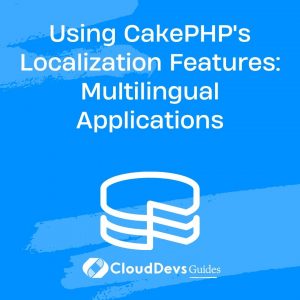Using CakePHP’s Localization Features: Multilingual Applications
In an increasingly globalized world, catering to users from diverse linguistic backgrounds is crucial for the success of web applications. As developers, it’s essential to offer a seamless experience to users regardless of their preferred language. This is where localization comes into play. In this blog post, we will delve into CakePHP’s robust localization features that empower developers to build multilingual applications effortlessly. From internationalization to language files and more, let’s explore how CakePHP can streamline the process of creating applications that speak the language of their users.
Table of Contents
1. Understanding Internationalization and Localization
Before we dive into CakePHP’s localization features, it’s important to grasp the concepts of internationalization (i18n) and localization (l10n). Internationalization involves designing and developing an application in a way that allows for easy adaptation to various languages and cultures. On the other hand, localization refers to the process of customizing the application to a specific locale by translating its content and adapting its components to suit cultural nuances.
2. CakePHP’s Approach to Localization
CakePHP, a popular PHP framework, simplifies the development of multilingual applications by providing a set of tools specifically designed for internationalization and localization. Let’s explore some of the key features that make CakePHP an excellent choice for building applications that cater to a global audience.
2.1. Language Files for Translations
At the heart of CakePHP’s localization capabilities are language files. These files store translation strings for different languages, allowing you to easily swap out content based on the user’s selected language. Language files are organized by locale and are typically found in the resources/locales directory of your CakePHP application.
Here’s a basic example of a language file (default.po) containing translation strings in English and Spanish:
po msgid "welcome_message" msgstr "Welcome to our application!" msgid "button_label" msgstr "Click Me"
2.2. Using Translation Functions
CakePHP provides convenient translation functions that enable you to retrieve translated strings based on the user’s selected locale. The primary function for this purpose is __() (double underscore), which takes a string key as an argument and returns its translated counterpart.
In your application’s code, you can use the __() function like this:
php
echo __("welcome_message");
If the user’s selected language is Spanish, the translated message “¡Bienvenido a nuestra aplicación!” will be displayed.
2.3. Locale-specific Formatting
Language isn’t the only aspect of localization; date, time, currency, and number formats also vary across cultures. CakePHP’s localization features extend to these aspects as well. You can easily format dates, numbers, and currencies according to the user’s locale using the I18n class.
For example, to display a formatted date:
php
use Cake\I18n\I18n;
I18n::setLocale('fr_FR');
echo I18n::localDate()->format('yyyy-MM-dd');
This code snippet sets the locale to French (France) and outputs a date in the format preferred by that locale.
2.4. Dynamic Content Translation
In addition to static content, CakePHP allows you to translate dynamic content, such as database records. You can use the TranslateBehavior to attach translations to your database records and retrieve them based on the selected locale. This is particularly useful for applications with content that can change over time.
To attach the TranslateBehavior to a table, you can use the following code:
php
public function initialize(array $config)
{
parent::initialize($config);
$this->addBehavior('Translate', ['fields' => ['name', 'description']]);
}
This code snippet configures the behavior to translate the name and description fields of the associated records.
3. Putting It All Together: Building a Multilingual Page
Let’s walk through the process of building a simple multilingual page using CakePHP’s localization features. In this example, we’ll create a page that displays a welcome message and a button label in different languages.
3.1. Create Language Files:
Start by creating language files for the desired languages in the resources/locales directory. For instance, you can have default.po for English and es_ES.po for Spanish.
3.2. Add Translation Strings:
Populate the language files with translation strings. Define translations for the welcome message and button label in each file.
3.3. Implement Translation in Views:
In your view file, use the __() function to display the translated content. For the welcome message:
php
echo __("welcome_message");
For the button label:
php
echo __("button_label");
Set User’s Locale:
Allow users to select their preferred language. When a user selects a language, set the locale using CakePHP’s I18n class.
php use Cake\I18n\I18n; // Set user's selected locale $selectedLocale = getUserSelectedLocale(); // Replace with actual logic I18n::setLocale($selectedLocale);
Conclusion
Building multilingual applications is no longer a complex and daunting task, thanks to CakePHP’s powerful localization features. By leveraging language files, translation functions, and locale-specific formatting, developers can create seamless user experiences for individuals around the world. Whether you’re catering to two languages or a dozen, CakePHP streamlines the process of adapting your application to different cultures and languages, enabling you to reach a broader audience and make a lasting global impact. Start exploring CakePHP’s localization capabilities today and take your applications to new linguistic heights!
Table of Contents








